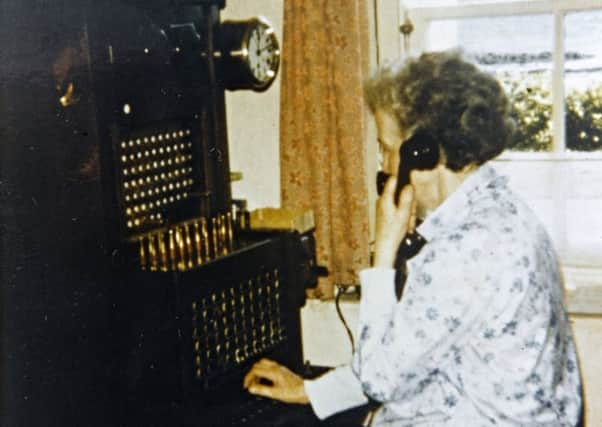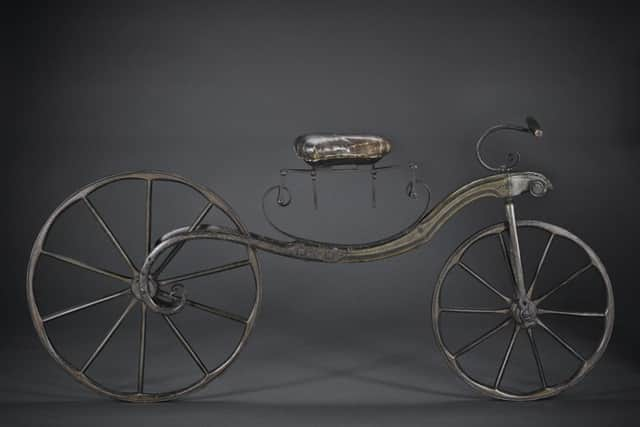Telling the story of Scots-led innovations at the national museum


For all the spectacularly diverse nature of the six new science and technology galleries, if they share a unifying theme it is that of progression. Whether in telecommunications, biomedicine or bicycles, a certain progression of ideas, innovation and development advances technology, though not necessarily in a conveniently linear way. As principal curator of technology, Klaus Staubermann, explains: “We’re displaying science and technology so that it doesn’t look theoretical but part of a process. To talk about ‘progression’ is good, because it suggests you’re doing it in small stages: you problem-solve, you troubleshoot and by doing this you build on the shoulders of others and build up what we consider today as science and engineering.”
Bicycles
So far as the history of the bicycle is concerned, the three from the museum collections shown here suggest an unusual case of relatively linear progression of innovation and development. The 1820 hobby horse, once owned by the Earl of Eglinton in Ayrshire, is an example of the laufmaschine or “running machine” invented by the German Karl Drais in 1817. Stories conflict, but it is widely thought that around 1839 a Dumfriesshire blacksmith, Kirkpatrick Macmillan, added technology that would have been familiar to him – treadles, rods and cranks – to a hobby horse, enabling it to be “treadled”, if not quite pedalled.


Advertisement
Hide AdAdvertisement
Hide AdThen, around 1865 Pierre Michaux or Pierre Lalliment fitted cranks and pedals directly to the front wheel of a hobby horse, creating the velocipede, thousands of which were manufactured. With no gearing, the only way to enable slower pedalling was to make the front wheel larger which, with Eugène Meyer’s invention of the wire spoke wheel, resulted in the distinctive penny farthing shown here.
The chain driven safety bicycle wouldn’t emerge until the 1880s and 90s, while the 20th century saw various innovations and refinements such as the Moulton bicycle with its small wheels and suspension. A major revolution in cycle construction, however, was the world’s first carbon-fibre monocoque bicycle, lightweight and aerodynamic. It was designed and built in 1985 by the Norfolk-based Mike Burrows, who went on to build the racing cycle for Lotus that Chris Boardman pedalled to a gold medal in the 1992 Olympic Games in Barcelona.
Prosthetics
The science of prosthetics or artificial limbs responds to the urgent needs of children and adults who have lost limbs through illness, accident or conflict. Edinburgh has been a world leader in prosthetic research and development since the Thalidomide tragedy of the 1960s, when the pioneering bioengineer David Simpson, based at the city’s Princess Margaret Rose Hospital, developed pneumatically powered arms, a prototype of the second type of which is illustrated here, designed for young children whose limbs had not developed normally due to Thalidomide.


The bioengineering centre at the Princess Margaret Rose continued to develop and in 1998 David Gow won international recognition for developing the world’s first bionic arm, the Edinburgh Modular Arm System (EMAS). With its ground-breaking electrically powered shoulder, elbow, wrist and hand, the arm, fitted to hotelier Campbell Aird, who had lost his own arm due to cancer, found its way into the Guinness Book of Records.
In 2003 Gow established a spin-off company, Touch EMAS, now the Livingston-based Touch Bionics, which went on to produce the i-limb, the world’s first prosthetic hand to feature five individually powered fingers. The museum is exhibiting two examples, one from 2008 and a current model which can be controlled by the wearer using a mobile phone app (and also by visitors to the gallery using a touch screen).
By the end of last year, more than 5,000 patients had been fitted with Touch Bionics’ products. Edinburgh’s world standing in prosthetics research remains a classic example of need driving invention and development.
Telephones
Examples of sheer pioneering spirit, the steampunk-looking hand receiver-speakers shown here, known as the Paisley telephones, were the first in Scotland and very probably in Europe. They were fashioned in 1877 – just a year after Alexander Graham Bell was granted his telephone patent in the United States – by two ingenious young Paisley men, James Reid and William Holms.
Advertisement
Hide AdAdvertisement
Hide AdReid and Holms had already established a telegraph link between their houses, and were inspired by a lecture given by Lord Kelvin, who had returned from the States enthusiastic about Bell’s invention. Working from sketches and descriptions of Bell’s device, Reid cannibalised his mother’s mahogany curtain rails to make the receiver-speakers.
Many first used a telephone in the trenches during the First World War, an example of people having access to new technology, seeing its benefits, and driving development. As urban then rural telephone networks grew, so too did the need for exchanges. From 1949 until 1974 the manual exchange shown was installed in the home of the redoubtable Effie Macdougall on the Isle of Jura, when it was replaced by an automated system. Among callers Effie is said to have connected was one Eric Blair – George Orwell – during his stay on Jura. A fluent Gaelic-speaker, Effie famously had a parrot, Patsy, who used to mimic her operator phrases.
Mobile phones emerged from radio rather than from telephone technology, with radio phones then car phones being early examples of people communicating on the move. The classic “brick” illustrated here is a Motorola DynaTAC from 1985 – as sported by Gordon Gekko in the movie Wall Street.
Medical imaging
In the ongoing quest to understand what goes on in our bodies – and particularly our brains – scientific understanding has transformed dramatically over the past century and a half since this phrenological head was made in Pathhead, Midlothian, by Francisco Mitchelelle, probably an itinerant figuremaker. Phrenology was the then widely accepted “science of mind” which held that the brain, its behaviour and pathology could be divined from measuring and assessing the “bumps” and other features of the cranium. Edinburgh was a hotbed, with the world’s first phrenological society being based just across Chambers Street from the museum, in what is now the Crown Office.
Jumping forward a century, the second item is the “Mouse Box”, a prototype magnetic resonance imaging (MRI) scanner designed by Professor John Mallard and his team at Aberdeen University in 1974. It clearly showed the fluid around the broken neck of a dead mouse, and the team went on to develop a human-sized machine and took the very first clinical image, of a patient with terminal cancer, showing that the cancer had spread to other parts of the body. The team also worked on Positron Emission Resonance Tomography (PET) scanning. The university licensed the ground-breaking technology, which is widely used to visualise the anatomy and workings of the living brain.
The third object was designed specifically for the museum’s displays, and uses an MRI technique known as diffusion tensor imaging to create a wonderfully delicate 3D image, etched within a glass block, of a living brain’s nerve tracts branching like coral.